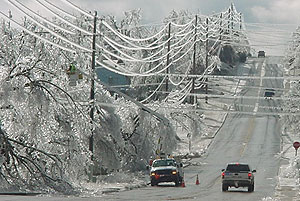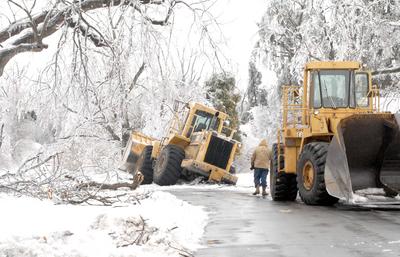Ice Storm 2009: Realtime Disaster Preparation?
Editorial thoughts for editorial thoughts.
Slides/audio on this topic.
What would a "big one" quake recovery be like? Perhaps the recent ice storm gave reasonably good indication.
The ice storm of late January and early February 2009
seriously disrupted power in the (nearly exact) boundaries of the
New Madrid Fault, as described by author David Stewart.
That's from Benton, Mo., just south of Cape Girardeau, to
just beyond Blytheville, Ar.
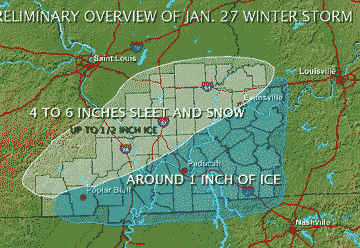
NWS Paducah
See story datelined Frankfort, on
this page. The head of Ky Emergency Mgt. says:
1. we made a plan last year, used it, and it worked
2. this was similar to a worst-case
quake scenario
A stream of Gulf moisture met cold arctic air, creating a 36-hour dump of mixed frozen precipitation in a 50-100 mile swath from Oklahoma to West Virginia. Many mature trees in the hardest hit areas are ruined. Some older building roofs collapsed.
"What SEMO Electric built over a period of more than 70 years, Mother Nature has taken down in a couple days," said Glen Cantrell, communications manager for the SEMO Electrical Cooperative, surrounding Sikeston. "It's almost rebuilding everything and it's going to take time."
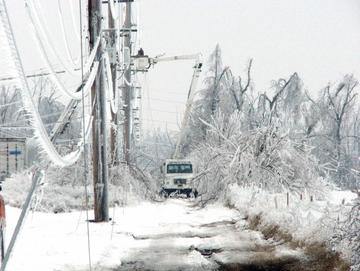 Someone
counted 95 power poles broken between Dexter and Sikeston.
Hundreds of linemen were imported, some of which specialize in
rebuilding storm damaged lines. They worked 16 hour days, amid
reports that some users might be out of power for several weeks.
For several, the lights came on, intermittently at first, within
less than a week, even in hard-hit Sikeston and Paducah. Rural
locations took more time.
Someone
counted 95 power poles broken between Dexter and Sikeston.
Hundreds of linemen were imported, some of which specialize in
rebuilding storm damaged lines. They worked 16 hour days, amid
reports that some users might be out of power for several weeks.
For several, the lights came on, intermittently at first, within
less than a week, even in hard-hit Sikeston and Paducah. Rural
locations took more time.
(Photo: Sikeston Standard)
We (webmaster of this site) work in a major grocery store in Cape Girardeau, the nearest functional grocery for many in the Bootheel, and as far away as Mayfield and Murray Kentucky, 90+ minutes away.
The morale we saw among affected people was unanimously high, as they described how they were "making it, ok" by heating with a gas oven, fireplace, propane heater, generator, or staying with friends and relatives. Municipal water was unavailable at different times and places.
Several described Sikeston as looking like a "war
zone" with downed power lines and tree limbs. Paducah was
similarly hit. Madisonville, Ky. was 95% without power for a few
days. Someone north of Cairo IL, with no furnace blower running,
said the continual sound of tree limbs breaking from the ice,
sounded like a war zone. Several had purchased generators
after a similar ice storm 11 months earlier. 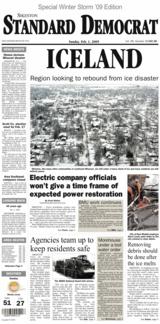
Functional gas stations were few and far between, and lines at working stations were long. Some stores in the affected area accepted cash only. Banks were closed, or had limited hours. Debit cards to bank accounts in the affected area would sometimes not work as a debit, but would work if run as a credit. Many stores do not have an option on which to use.
A Paducah minister told his people, "This is a memorable event like the 1937 (Ohio River) flood."
This experience will give some generations of people the experience and memories to draw from, to say "yes, we can make it" by using common sense, respect for others, and common values that exist among all income and education and ethnic differences. Perhaps we need to spend government bucks to study such. A major quake will undoubtedly cause MORE stress to a WIDER area, and MORE economic disruption than an ice storm, perhaps for years. How should we better get ready?
We've heard a credible-sounding story that someone who owns land along the Mississippi River near here, cut a path through trees, and managed to get an old barge several hundred feet up a hill, for a Noah's-ark-style getaway in event of a quake. A relative of mine has similar visions, that the entire region could submerge. Well, it's true that the river bottom flatland New Madrid-Caruthersville area might see some of this, as they did 198 years ago. We don't know how soon, how much (or if ever). Type of soil and location does play a factor. Examining this for myself and anyone else interested, is why I did this site.
Photo below left is from Springfield, Mo. On right: Sikeston area
|
|
NEW YORK (Reuters) Jan 28, 2009 - Snow and ice storms across the U.S. Midwest knocked out power to more than 870,000 homes and businesses from Oklahoma to West Virginia on Wednesday, local utilities reported.
---
Sunday, February 1, 2009; Page A12 Washington Post
All Guardsmen in Ky. Called to Ice Storm Duty
MAYFIELD, Ky. -- Gov. Steve Beshear called up his entire National Guard on Saturday, with his state reeling from a deadly ice storm that knocked out power from the Midwest to the East Coast.
More than half a million homes and businesses, most of them in Kentucky, remained without electricity from the Ozarks through Appalachia, though temperatures creeping into the 40s helped utility workers make headway.
Finding fuel -- heating oil, gas for cars and generators -- was a struggle for those trying to tough it out at home, with hospitals and other essential services getting priority.
The addition of 3,000 soldiers and airmen means 4,600 guardsmen have been pressed into service. It's the largest call-up in Kentucky history, which Beshear called an appropriate response to a storm that cut power to more than 600,000 people, the state's largest outage on record.
---
Thousands bide time in shelters after ice storm
Jan 30, 2009
MURRAY, Ky. (AP) — Utility crews made some progress Friday in restoring power to the more than 1.3 million homes and businesses darkened by an ice storm that crippled states from Missouri to West Virginia, but thousands were still bunking in toasty shelters because their homes had no water or heat.
At Murray University in southwestern Kentucky, brothers Jim McClung, 42, and Dale Earnest, 38, were among those resting in every corner of a university theater. Some sprawled in aisles, propped in chairs or curled up on the stage. They, like many others, ran out of food and water at their frigid, powerless home.
Deputies trekked door-to-door in many communities to let people know where shelters were, forced to spread the word the old-fashioned way because cell phone and Internet service was spotty. In some towns, volunteers checked to make sure their elderly and disabled neighbors were all right.
Many Kentucky hotels offering discounted "power outage rates" reported being fully booked with people escaping frosty neighborhoods. Those who hunkered down in their homes face long lines to buy generators, firewood, groceries — even bottled water because power outages crippled local pumping stations.
As power came back on in the northwest corner of Tennessee, Kentucky residents flocked there for supplies. Obion Co. Propane Gas general manager Ken Walker said more than 200 people came to his Union City shop to fill propane tanks. On an average day he has 5 customers.
Truckloads of ready-to-eat meals, water and generators from the Federal Emergency Management Agency were expected to arrive Friday at a staging area in Fort Campbell, Ky., said Mary Hudak, a spokeswoman for FEMA's southeast region.
In Paducah, 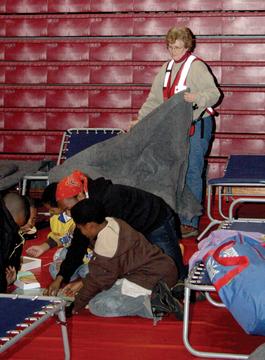 Amber Fiers and her neighbor Miranda Brittan tried a
half-dozen filling stations before finding one where they could
buy kerosene. The two were in a line that swelled to 50 or more
at the 13th Street Station, which began pumping kerosene after
its owner set up a generator.
Amber Fiers and her neighbor Miranda Brittan tried a
half-dozen filling stations before finding one where they could
buy kerosene. The two were in a line that swelled to 50 or more
at the 13th Street Station, which began pumping kerosene after
its owner set up a generator.
Jimmy Eason was among those who decided to tough it out anyway in Velvet Ridge, Ark., gingerly stepping across his yard, watching for icicles falling from electrical wires. He was headed to his Ford F-150 pickup truck, which was warmer than his one-story house.
"I'm sleeping in a car, which is just fine," Eason, 74, said. "There's nothing wrong with a car. Every couple of hours I turn it on, I let it run for 10 minutes and that keeps it pretty warm."
Eason was trying to avoid boredom, and drove to Burger King to get a meal because he was tired of eating cold soup. "It's kind of a chore to occupy your mind. I'm used to doing things and keeping busy," he said. "You just have to endure a couple of days and it will be all right."
Photo above: Sikeston school field house emergency shelter. Below: possibly all Sikeston.
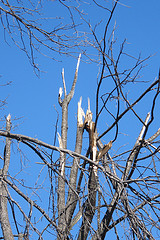
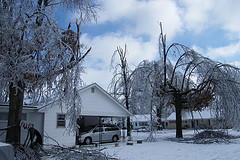
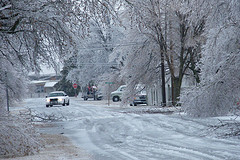
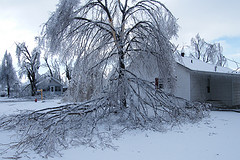
Official: Earthquake training worked for ice storm
By JOE BIESK
(Published February 08, 2009)
FRANKFORT, Ky. — The scenario is frightening: Hundreds of
thousands of Kentuckians, many in far-flung rural areas, left in
dire circumstances by a major natural disaster. Cut off, they
have no electric power, no way to call for help and all roads are
blocked.
It's a scenario Brig. Gen. John Heltzel, the head of Kentucky's Division of Emergency Management, has planned for in tge event of a major earthquake. Experts have warned such a quake could occur some time in the future along western Kentucky's New Madrid fault.
But it so happens it's eerily similar to what occurred Jan. 27 when, instead of the earth shaking, a brutal winter storm encased much of the state in ice up to an inch thick. The state's worst natural disaster in recent history left a record 769,000 without electricity, killed 30 people and sent thousands fleeing to shelters.
So Heltzel used a statewide earthquake training held last March as a rescue blueprint for the ice storm, and credits that preparation with saving lives from the storm.
"Lifesaving, that's priority one for us, so that's what we were able to do," Heltzel told The Associated Press. "It wasn't perfect, but it was much better because we had plans that we could execute."
One step the state took was to call up the entire Kentucky National Guard to help go door-to-door and check on residents. Guardsmen are credited with rescuing an elderly couple suffering from carbon monoxide poisoning in their house and helping save a group of teenagers whose car had plunged into a water-filled ditch.
"It's near the worst-case scenario," Heltzel said of the ice storm. "I'm not sure I could come up with a scenario that would be much worse. From an infrastructure standpoint, it equals what we expect to have with New Madrid."
For instance, communication was cut off or limited in the western half of the state for days and Kentucky's power grid was obliterated, he said.
The New Madrid fault spans from southern Illinois to northeastern Arkansas and produces hundreds of small quakes each year, but most go unnoticed without scientific equipment. A series of big earthquakes estimated at magnitude 7.0 or greater, however, hit the region in 1811 and 1812, and are considered by the U.S. Geological Survey to be of the largest ever in the U.S.
Experts predict that an earthquake of that magnitude today would cause widespread destruction.
Gov. Steve Beshear said Heltzel has been "an invaluable resource."
"His ability to work together and coordinate efforts with county, state and federal officials has ensured that the most assistance possible has reached hundreds of thousands of Kentuckians in need," the Democrat said.
Heltzel was commissioned in the Kentucky National Guard in 1979 out of Eastern Kentucky University. Beshear appointed him director of Kentucky's Division of Emergency Management in July.
A mere two months later, remnants of Hurricane Ike brought hurricane-force winds to Kentucky, leaving 600,000 electric customers without power, a state record at the time.
Then came January's ice storm.
With communications largely down and many roads impassable, state officials were cut off from much of western Kentucky during the first days after the storm, Heltzel said. He credits county officials first to respond - and who set up shelters - with keeping the death toll from being much higher.
"We'd be talking hundreds of lives, potentially, and that is directly attributable to those county emergency directors who stepped up in the middle of this thing," Heltzel said. "The real heroes of this -the initial heroes - are those guys at the county level."
Still, Heltzel says the state needs to upgrade some of its tools for dealing with statewide disasters. County emergency operation centers throughout the state should have satellite communication, a generator and a store room stocked with ready to eat meals, he said. A statewide shelter plan is also something the state needs, Heltzel said.
And, the state's emergency operations center - forefront technology in the 1970s - could use some upgrades, he said. It's needs to be bigger and more technologically aligned, Heltzel said.
"The reality is that today's environment and the amount of things that have to be coordinated greatly outstrips what we ever thought about in the 1970s," Heltzel said.
http://www.fortmilltimes.com/124/story/451495.html
